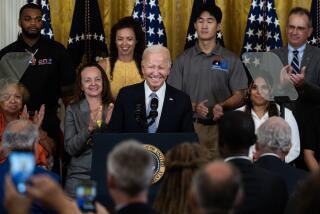Dramatic Events Helped Corner Elusive Industry
- Share via
WASHINGTON — The landmark tobacco settlement reached Friday represents a dramatic about-face for an industry that for years had lived in a parallel universe--successfully defying public and scientific opinion and thriving in a legal system that had clobbered other makers of dangerous products.
The short explanation for the tobacco peace accord is that public vilification and the endless barrage of mega-lawsuits finally became more than the $50-billion-a-year industry could bear.
“The image that comes to my mind is a fox hunt, where you have 30 dogs chasing a lone fox through the forest,” said Stephen Gillers, a New York University law professor.
Once tobacco foes “got enough dogs together to cover the forest . . . the fox is cornered and makes a deal.”
More than three decades of anti-smoking activism had caused little real damage to the industry. But the dogs began closing in for real in 1994, when a series of dramatic events, each reinforcing the others, unalterably shifted the balance of power in the smoking wars.
The first bombshell fell in late February of that year, when Food and Drug Administration commissioner Dr. David Kessler announced an investigation into whether tobacco companies deliberately manipulated nicotine levels to keep smokers hooked. The probe led to the FDA’s adoption of marketing curbs meant to reduce teenage smoking.
In April of that year, top tobacco executives testified before Congress that they did not believe nicotine was addictive. With impeccable timing, a cache of explosive internal documents from the Brown & Williamson Tobacco Corp. that seemed to impeach the testimony then were leaked to members of Congress and the news media and posted on the Internet.
Even hardened foes of the industry were shocked by the blunt concessions in the documents, which appeared to contradict long-standing industry denials that its products were dangerous and addictive.
Said one 1963 memo by B&W;’s chief counsel: “We are . . . in the business of selling nicotine, an addictive drug.”
The trove of documents had been purloined and leaked by Merrell Williams, a paralegal for one of B&W;’s law firms. An immediate result was the start of a Justice Department perjury investigation of the tobacco executives who had just testified before Congress. The probe has since been widened to focus on whether the industry committed fraud in statements to stockholders, the public and government agencies.
Other whistle-blowers and secret papers surfaced about the same time, reverberating loudly in the courts.
Damage Suits Flicked Away
The industry for decades had flicked away damage suits in which individual smokers or their families sought compensation for illness or death. The companies had the advantage of superior resources and a simple but highly effective argument: Individuals made their own decisions to smoke and should accept the consequences of their personal choice.
Meanwhile, in New Orleans, a successful plaintiff’s lawyer, Wendell Gauthier, was seeking to avenge the death of his best friend, Peter Castano, a heavy smoker, who had died of lung cancer. But Gauthier had concluded that traditional claims by single smokers were doomed.
Yet, the tobacco companies hadn’t warned people about addiction; nor had anti-tobacco lawyers tried bundling together multiple claims and teaming up to even the odds. Gauthier organized a nationwide consortium of more than 60 plaintiff law firms, known as the Castano group, which filed a class-action suit on behalf of all addicted U.S. smokers in March 1994.
A federal appeals court later threw out the suit as too unwieldy, but the Castano lawyers responded by filing more than 15 statewide class actions on behalf of millions of smokers.
Also during the spring of 1994, government and private lawyers in Mississippi were brainstorming an even more novel and potent evasion of the personal-choice defense.
Arguing that his state’s taxpayers had never made a decision to smoke, Mississippi Atty. General Michael Moore filed a lawsuit in May 1994 seeking recovery of Medicaid funds the state had spent to treat poor people suffering from smoking-related illnesses.
Other states began following Mississippi’s lead, and attorneys general who were philosophically opposed--or thought the suits would fail--came under pressure to line up for tobacco loot. By this week, 40 states, representing more than 90% of the U.S. population, were involved in the Medicaid cases.
Nothing like it had happened in the annals of civil litigation. In essence, nearly every adult American was being portrayed as a victim of tobacco--if not as a current or former smoker, then as a taxpayer.
To make matters worse for tobacco forces, a small Florida law firm last August won a $750,000 verdict against Brown & Williamson in the case of a longtime smoker who contracted lung cancer. Coming in an individual lawsuit of the type that seemed least threatening to the industry, the verdict gave the anti-smoking forces a big psychological boost.
Two crowning blows landed earlier this year.
In March, Liggett Group Inc., the smallest of the major cigarette makers, broke from its industry peers: It concluded the second of a pair of settlements with attorneys general and agreed to turn over a trove of confidential documents. In so doing, Liggett shattered an industry taboo--acknowledging that cigarettes cause cancer and addict their users.
Then, in April, a federal judge in the tobacco stronghold of North Carolina--a venue chosen by the industry--upheld the FDA’s authority to regulate tobacco.
The industry’s defenses remained strong and its trial skills formidable. But even if it won most of them, it began to seem highly probable it would also lose at least some of the cases. And with the states and class-action claimants seeking billions of dollars in compensation--and punitive damages on top of those--it would not have taken many losses to imperil the companies’ tobacco operations as well as their cookie, cheese and beer businesses.
The pending litigation also assured a steady stream of pretrial news coverage, much of it highly negative. The evils of smoking had become a popular staple of grade school poster art. In the political arena, tobacco had become such a “leper industry,” in the words of a congressional aide, that the costs of its support outweighed the benefits.
Tobacco Floats Idea of Accord
More than a year ago, Steven Goldstone, chief executive of RJR Nabisco, whose R.J. Reynolds Tobacco Co. is the No. 2 cigarette maker, first publicly suggested the unthinkable--that the industry might entertain an accord with its adversaries.
By background and outlook, Goldstone was not a traditional tobacco man, but a corporate lawyer from the prominent New York firm of Davis, Polk & Wardwell, who was appointed general counsel of RJR and promoted from there.
As Reynolds’ top in-house lawyer, Goldstone had confided that “the preferred route for him would be to . . . settle or reach a legislative solution rather than to go on fighting,” recalled Martin Feldman, a tobacco analyst with Smith Barney & Co.
Last summer, a settlement trial balloon was floated by Richard Scruggs--a Mississippi lawyer working on that state’s Medicaid case and brother-in-law of Sen. Majority Leader Trent Lott (R-Miss.). Containing less than half the money and lacking most of the public health provisions of Friday’s agreement, it was assailed by tobacco foes as a sweetheart deal.
But with the list of massive state lawsuits rising almost weekly--and the first Medicaid trial scheduled for July 7 in Mississippi--talks began in earnest about April 1.
The appeal of Friday’s deal to the fox is clear: It eliminates the threat of Medicaid and class-action suits. Individual damage claims will be allowed with some restrictions and the predictable annual payout for legal liability is likely to lift stock prices.
The attraction for the dogs is also clear.
The states and class-action claimants get a vast pool of money--without waiting for trials they could lose, or sweating through appeals that might reduce or eliminate whatever they won.
Millions of Dollars in Legal Fees
Private anti-tobacco lawyers will reap millions of dollars in legal fees. Attorneys general will bask in the political glory of having slain the tobacco dinosaur and brought wealth to their states while they are still in office, or campaigning for their next jobs.
Nor could the deal’s public health provisions--from curbs on tobacco marketing to a lavishly financed anti-smoking advertising campaign--have been secured through a typical courtroom victory or settlement.
According to David Adelman, vice president and tobacco analyst at Morgan Stanley, the agreement “will lead to higher stock prices for the industry, it will help the attorney generals’ career prospects, it will pay a lot of money to the plaintiffs’ attorneys, and it will reduce youth smoking.”
Whether the public, and Congress, will be impressed with the outcome is the $368.5-billion question. But even if Congress seeks tougher concessions, the industry will be hard pressed to back out.
“They can’t put the genie back in the bottle and go back to denying those things that they have historically denied,” said a congressional aide. “They are so deeply into this that they have to make it work.”
More to Read
Inside the business of entertainment
The Wide Shot brings you news, analysis and insights on everything from streaming wars to production — and what it all means for the future.
You may occasionally receive promotional content from the Los Angeles Times.










